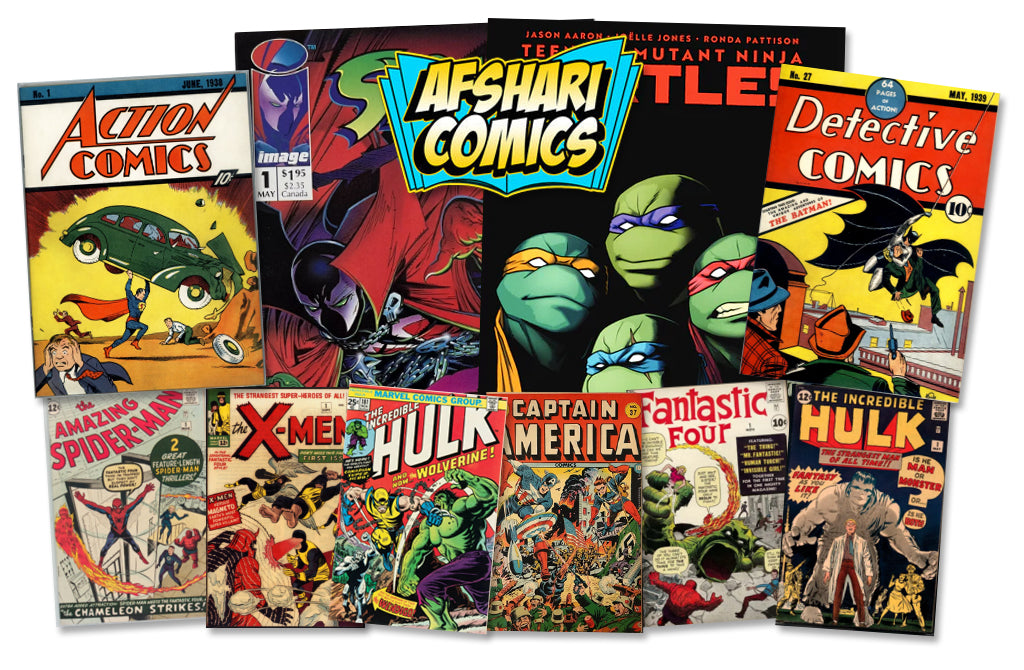Celebrating 40 Years of the Teenage Mutant Ninja Turtles
As we mark the 40th anniversary of the Teenage Mutant Ninja Turtles (TMNT), it’s a perfect time to reflect on the extraordinary journey of these iconic characters. From their humble beginnings in an indie comic book to becoming a global pop culture phenomenon, the TMNT have captivated generations of fans. This article delves into the origins of the Teenage Mutant Ninja Turtles, the creative minds behind them, and their enduring popularity in the world of comic books, with a special focus on exclusive variant covers published by Afshari Comics.
TMNT The Origin Story
The story of the Teenage Mutant Ninja Turtles began in the early 1980s when Kevin Eastman and Peter Laird, two aspiring comic book artists, decided to create something unique and entertaining. Inspired by a combination of their love for comic books and the absurdity of mixing various genres, Eastman and Laird came up with the concept of four mutant turtles trained in ninjitsu by a rat sensei named Splinter.
Eastman and Laird’s original idea was conceived as a parody of popular comic books of the time, particularly Frank Miller’s dark and gritty Daredevil series. They combined elements of superheroes, ninjas, and anthropomorphic animals to create the TMNT. The turtles' names—Leonardo, Michelangelo, Donatello, and Raphael—were a playful nod to the Renaissance artists, adding a layer of sophistication to the otherwise outlandish concept.
In May 1984, Eastman and Laird self-published the first issue of Teenage Mutant Ninja Turtles under the banner of Mirage Studios, named after their own lack of an actual studio. The initial print run of 3,000 copies quickly sold out, surprising the creators and setting the stage for the turtles’ rapid rise to fame.
TMNT Creators: Kevin Eastman and Peter Laird
Kevin Eastman and Peter Laird's partnership was marked by a shared passion for comic books and storytelling. Eastman, born in Portland, Maine, in 1962, was an avid comic book reader and artist from a young age. Peter Laird, born in North Adams, Massachusetts, in 1954, had a background in art and had worked as an illustrator before teaming up with Eastman.
Their collaboration began when Eastman moved to Northampton, Massachusetts, where Laird lived. The two quickly bonded over their mutual interests and began working on various comic book projects. The creation of the TMNT was a spontaneous idea that emerged from a brainstorming session, with Eastman sketching a humorous drawing of a “ninja turtle” that Laird immediately found intriguing.
The duo’s dynamic partnership combined Eastman’s energetic creativity with Laird’s meticulous attention to detail, resulting in a compelling and unique comic book series. Despite their later creative differences and eventual split, the impact of their collaboration remains undeniable.

The 40th Anniversary of the Teenage Mutant Ninja Turtles
Rise to Popularity
The success of the first TMNT comic book issue was just the beginning. The turtles quickly gained a dedicated fanbase, and Eastman and Laird expanded their universe with additional issues and story arcs. The comic’s distinctive blend of action, humor, and character development resonated with readers, and its popularity continued to grow.
In 1987, the Teenage Mutant Ninja Turtles made the leap from comic books to television with the debut of their animated series. The show introduced a wider audience to the turtles and their world, helping to cement their status as cultural icons. The catchy theme song, memorable catchphrases like “Cowabunga!” and the turtles’ distinct personalities endeared them to millions of viewers.
The animated series also introduced new characters, such as the villainous Shredder and the alien brain Krang, further expanding the TMNT universe. The show’s success led to an extensive line of action figures, toys, and merchandise, making the turtles a household name.
The first TMNT animated series ran for ten seasons, from 1987 to 1996, and was instrumental in establishing the franchise’s longevity. It was followed by several other animated series, live-action films, and reboots, each bringing new interpretations and adventures for the turtles.
The Comic Book Legacy: 40th Anniversary of TMNT
While the animated series and movies brought the TMNT to mainstream audiences, the comic books remained the heart of the franchise. Over the years, the TMNT comics have evolved, with different writers and artists contributing their own visions to the turtles’ world.
The original Mirage Studios run, which lasted from 1984 to 1995, is considered a classic, featuring darker and more mature storylines compared to the animated series. This series explored the turtles’ origins, their battles with the Foot Clan, and their struggles with identity and belonging.
In 2001, Mirage Studios revived the TMNT comic book series with a new volume, continuing the original continuity. This series delved deeper into the characters’ development and introduced new challenges and adversaries.
IDW Publishing acquired the TMNT comic book rights in 2011, launching a new ongoing series that reimagined the turtles’ origins while paying homage to their rich history. The IDW series has been praised for its fresh take on the characters, intricate storytelling, and stunning artwork. It has also introduced new characters and expanded the TMNT lore, keeping the series engaging for longtime fans and newcomers alike.
Afshari Comics and Exclusive Variant Covers for TMNT Comic Books
As part of the TMNT’s 40th anniversary celebrations, Afshari Comics has released a series of exclusive variant covers, showcasing the turtles in unique and visually striking ways. These covers have been designed by some of the most talented and respected artists in the comic book industry, adding an extra layer of collectibility and excitement for fans.
Afshari Comics, known for its dedication to high-quality publications and innovative approaches to comic book art, has partnered with renowned artists to create these exclusive variants. Each cover captures the essence of the TMNT while offering a fresh and contemporary perspective.
[Afshari Comics Teenage Mutant Ninja Turtles #4 Derrick Chew Virgin Variant Edition]
In addition to the 40th anniversary issues of TMNT, Afshari Comics has been putting out some amazing exclusive variant covers by outstanding comic book artists such as Derrick Chew, Rian Gonzales, Tony Moy, Kyle Willis, Javan Jordan, Görkem Demir, and other issues to be announced soon.
Afshari Comics isn’t the only one celebrating TMNT’s 40th with an exclusive variant cover. Among the standout variant covers are those by artist David Finch, whose intricate and dynamic illustrations bring the turtles to life in stunning detail. Finch’s covers feature the turtles in action-packed poses, highlighting their skills and personalities.
Another notable contribution comes from artist Jenny Frison, who has crafted elegant and evocative covers that focus on the turtles’ emotional depth and camaraderie. Frison’s art emphasizes the bond between the turtles and their sensei, Splinter, showcasing the family dynamics that are central to the TMNT story.
Afshari Comics has also released limited edition foil variants and sketch covers, offering fans the opportunity to own truly unique pieces of TMNT memorabilia. These exclusive covers have become highly sought after by collectors, reflecting the enduring appeal and cultural significance of the Teenage Mutant Ninja Turtles.
The Enduring Popularity of the TMNT
The Teenage Mutant Ninja Turtles’ ability to adapt and evolve has been key to their lasting popularity. Over the past four decades, the turtles have undergone numerous transformations, from their gritty comic book origins to their more lighthearted animated adventures and everything in between.
One of the reasons for the TMNT’s enduring appeal is their relatability. Despite their extraordinary abilities and fantastical setting, the turtles’ struggles with identity, family, and acceptance resonate with audiences of all ages. Their distinct personalities—Leonardo’s leadership, Michelangelo’s humor, Donatello’s intellect, and Raphael’s toughness—offer something for everyone to connect with.
The turtles’ adventures have also addressed relevant social and environmental issues, from pollution and urban decay to themes of loyalty and perseverance. These elements have added depth to their stories, making them more than just action-packed escapades.
The TMNT’s impact extends beyond comic books and television. They have become a staple of popular culture, referenced in music, film, and literature. Their influence can be seen in the countless parodies, homages, and tributes across various media. The turtles have also inspired a devoted fan community, with conventions, fan art, and cosplay celebrating their legacy.
[Teenage Mutant Ninja Turtles #6 Afshari Comics Exclusive Cover by Rian Gonzales]
Looking Ahead: The Future of the Heroes in a Half Shell
As the Teenage Mutant Ninja Turtles celebrate their 40th anniversary, their future looks as bright as ever. New comic book series, animated shows, and films continue to be developed, ensuring that the turtles remain a relevant and beloved part of pop culture.
Afshari Comics’ exclusive variant comics feature exclusive covers that are a testament to the TMNT’s enduring legacy and the creativity they inspire. These covers not only honor the turtles’ rich history but also pave the way for future generations of fans to discover and embrace their adventures.
Conclusion
The 40-year journey of the Teenage Mutant Ninja Turtles is a remarkable tale of creativity, resilience, and evolution. From their origins in a small independent comic book to becoming global icons, the TMNT have left an indelible mark on the world of entertainment. As we celebrate this milestone, we look forward to many more years of adventures with Leonardo, Michelangelo, Donatello, and Raphael—our heroes in a half shell. Cowabunga!









